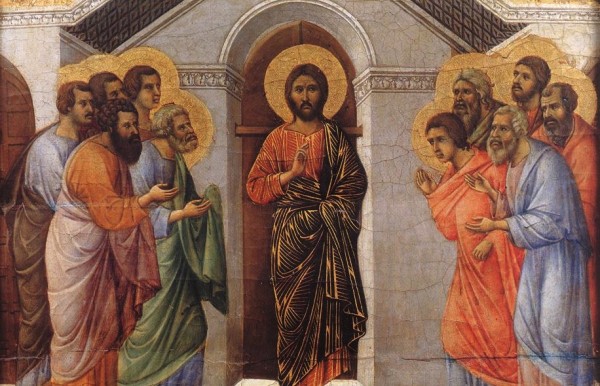How Do we Know the Gospels are Historical?
by Fr. Dwight Longenecker
Filed under The Bible
Among Catholics and atheists, is easy to exchange convinced assertions: “The gospels are 100% God’s holy Word and every bit is historically accurate!” or “The gospels are fairy tales!” However there is a discipline called “Biblical scholarship” in which scholars do some very interesting work determining just which parts of the gospels they think are reliable and which they think are not. Their conclusions are, of course, debated. That’s what scholars do. Their work is fascinating and it is worth taking some time to look at just a smidgen of their methodology and conclusions.
Bible scholars are most interested in trying to determine whether the original gospels record eyewitness accounts, and whether those original versions have been transmitted accurately. To do this scholars consider several factors: 1) authorship and date of composition, 2) intention and genre, 3) gospel sources and oral tradition, 4) textual criticism, 5) historical authenticity of specific sayings and narrative events.
One of the difficult aspects for modern people to understand is just what kind of document the gospels are. Everyone can admit that they are not written as purely historical documents, but neither are they simply fabulous fables, myths, or fairy tales. In continuity with the Old Testament, and consistent with their Jewish origins, we have documents which are presented as history and have plenty of historically verifiable details, but which also have supernatural and otherworldly elements to them. Thus:
"The genre of the gospels is essential in understanding the intentions of the authors regarding the historical value of the texts. New Testament scholar Graham Stanton states that 'the gospels are now widely considered to be a sub-set of the broad ancient literary genre of biographies.' Charles H. Talbert agrees that the gospels should be grouped with the Graeco-Roman biographies, but adds that such biographies included an element of mythology, and that the synoptic gospels also included elements of mythology. E.P. Sanders states that 'these Gospels were written with the intention of glorifying Jesus and are not strictly biographical in nature.' Ingrid Maisch and Anton Vögtle writing for Karl Rahner in his encyclopedia of theological terms indicate that that the gospels were written primarily as theological, not historical items. Erasmo Leiva-Merikakis notes that 'we must conclude, then, that the genre of the Gospel is not that of pure ‘history’; but neither is it that of myth, fairy tale, or legend. In fact, ‘gospel’ constitutes a genre all its own, a surprising novelty in the literature of the ancient world.'"
Historians therefore allow for the fact that these are essentially historical documents with what they call “mythological” elements woven into them. Whether the miracles or “the mythological elements” happened as the gospels report is open to debate. Believers accept the possibility of the miraculous. Non-believers do not. In each case the bias will affect the conclusion, however it must be said that one who believes miracles are possible is immediately more open-minded than one who rules that they are impossible. The believer is open therefore to more possibilities than the non-believer who, a priori, rules miracles out entirely.
What many people miss, because of a secular or a scientific bias (or both), is that this sort of story is common to humanity everywhere. The supernatural or “mythological” is woven into the lives and stories of many individuals, families, and cultures. Whether it is a near death experience, or a paranormal experience of some kind, or a more ordinary faith experience, people re-tell the remarkable things which have happened to them in ordinary life. Aunt Sally tells how she was healed at the summer camp revival meeting by Jesus Christ himself or Cousin Jimmy tells how he was miraculously preserved from falling headlong into a pot of acid by his guardian angel.
One does not have to accept that Aunt Sally was miraculously healed by Jesus to accept that she really did go to the revival meeting led by Pastor Billy Bob at the Hosannah Camp Meeting in Houndstooth, North Carolina on August third and that she went in feeling sick and came out feeling better. One does not have to accept the miraculous element of the story to acknowledge that Cousin Jimmy really did almost fall into a pot of acid, and that two workmates saw it happen at Florsheim Fertilizer Plant in Boondock Missouri on January 27 at 3:00 in the afternoon. In other words, it is reasonable to attempt to sift out what is verifiable and provable from a reported story which, by its nature, is subjective and perceived as supernatural and therefore not verifiable with ordinary means of enquiry.
This is what scholars quite sensibly do when confronted with the gospel accounts. The scholarship on the questions of authorship, date, sources, and genre is a scholarly industry in itself, but the topic for this post is the various tools used to help determine whether particular sayings or events from the recorded gospel accounts are authentic.
There are different scholarly means used to analyze the text. The first tool scholars use is called ‘criterion of dissimilarity’. This says if something Jesus did or said clashed with the Jewish religion of his day (and therefore the religion of the first Christians) then it is more likely to be authentic. There are many examples of this. Indeed the whole gospel story can be seen as subversive to the existing Jewish religion. However, some specific examples would be Jesus talking alone to the woman at the well in Samaria, or the story of the Good Samaritan, or Jesus and his disciples breaking the Sabbath rules, or Jesus sharing the hospitality of sinners, or standing the Ten Commandments on their head with his Sermon on the Mount.
Second, the ‘criterion of embarrassment’ says that if a saying or event was embarrassing to the memory of Jesus or the apostles it is more likely to be authentic. So Jesus losing his temper, clearing out the temple ,or calling a woman a ‘dog’ are all examples. The apostles being proud, vain, and doubting is another. So the story of Jesus being baptized by John would be authentic because it shows Jesus to be subordinate to John. Other examples include the supposed illegitimacy of Jesus’ birth and the most obvious—his execution as a criminal.
Third, the ‘criterion of multiple attestation’ says that “when two or more independent sources present similar or consistent accounts, it is more likely that the accounts are accurate reports of events or that they are reporting a tradition which pre-dates the sources themselves.” This is often used to note that the four gospels attest to most of the same events, but that Paul’s epistles often attest to these events as well, as do the writings of the early church, and to a limited degree non-Christian ancient writings.
Fourth, the ‘criterion of cultural and historical congruency’ says that a source is less credible if the account contradicts known historical facts, or if it conflicts with cultural practices common in the period in question. Conversely, if the account matches up with the other known facts it is more likely to be authentic. So the gospel stories are evaluated to see if they match with the known historical facts, the geography, archeological findings, cultural customs, and details etc.
It should be noted that the results of these methods of textual analysis are not always unanimously in favor of the historicity of the gospels. However, the results are significantly satisfactory for professional historians and Biblical scholars working together to show that the gospels are, for the most part, historically reliable documents.
One of the aspects of this analysis most often overlooked is the cross-referencing between the epistles of St. Paul and the gospels. Scholars are virtually unanimous in recognizing most of the Pauline epistles to be written before his death, which occured during the Neronian persecutions in the year 65. While not personally an eyewitness of Jesus’ ministry, the Book of Acts shows that he knew the other apostles and indeed went to them for instruction and validation of his ministry. Most importantly, Paul's epistles are not written as gospels with the intention to glorify Jesus and make converts. They are letters to the early Christian communities scattered around the Roman Empire. They are therefore very accurate reflections of the people in those early communities and are accurate records of the beliefs of those early communities.
In his epistles, Paul quotes early Christian creeds that obviously pre-date his own writing. Scholars believe these creeds date to within a few years of Jesus’ death and developed in the early Christian communities. These texts are therefore an important and unique source for the study of early Christianity. For example, 1 Corinthians 15:3-4 reads: “For what I received I passed on to you as of first importance: that Christ died for our sins according to the Scriptures, that he was buried, that he was raised on the third day according to the Scriptures.” The language formulations are different from Paul’s own and he is therefore quoting a mini-creed that is even earlier than his own writings, making it pre-65 AD. The antiquity of the creed has been located by many Biblical scholars to less than a decade after Jesus’ death, originating from the Jerusalem apostolic community.
Concerning this creed, New Testament scholar Hans Von Campenhausen says, “This account meets all the demands of historical reliability that could possibly be made of such a text,” and A. M. Hunter writes, “The passage therefore preserves uniquely early and verifiable testimony. It meets every reasonable demand of historical reliability.”
This is just one of about half a dozen early creeds embedded in the writings of Paul. Here are some others:
- 1 John 4:2: “This is how you can recognize the Spirit of God: Every spirit that acknowledges that Jesus Christ has come in the flesh is from God.”
- Romans 1:3: “Regarding his Son, who as to his human nature was a descendant of David, and who through the spirit of holiness was declared with power to be the Son of God by his resurrection from the dead: Jesus Christ our Lord.”
- 1 Timothy 3:16: “He appeared in a body, was vindicated by the Spirit, was seen by angels, was preached among the nations, was believed on in the world, was taken up in glory.”
Why does this matter? What these early Christian creeds show is that the so-called mythological elements of the gospels (angels, resurrection, ascension into heaven, Son of God) were not later additions and accretions to the tradition, but were part of the beliefs about Jesus from the very earliest days, beliefs that the gospels attest to, Paul affirms, and Christians today still hold.
Related Posts
Note: Our goal is to cultivate serious and respectful dialogue. While it's OK to disagree—even encouraged!—any snarky, offensive, or off-topic comments will be deleted. Before commenting please read the Commenting Rules and Tips. If you're having trouble commenting, read the Commenting Instructions.













